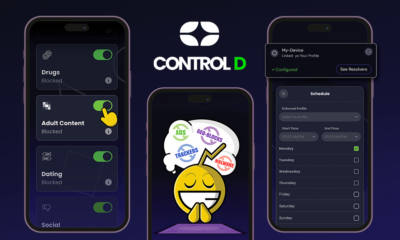TECHNOLOGY
5 key stages for product lifecycle success

Amir Jerbi, CTO of Aqua Security, explores how best to ensure new products hit their mark from day one – and continue to evolve and succeed.
History is littered with failed product launches, which, despite significant investment, simply haven’t paid off. From New Coke in the 80s to the Apple Newton in the 90s to the more recent collapse of the billion-dollar Quibi microstreaming platform, there are plenty of examples of how big businesses have misread their market and consumer base.
Bringing the experience of numerous product launches and personal patents, I have some first-hand knowledge of how best to bring a new concept to market – and some of the common pitfalls. At its simplest, there is a five-step framework which will help you meet your objectives when it comes to introducing a new product. Let’s explore these in more detail:
Stage Zero: Research, experiment, and learn
Begin by understanding the problem you are trying to solve in detail. Interview customers and prospects to find out what specific challenges they are facing. Evaluate the competition and identify gaps in the market.
From a personal perspective, when we were founding Aqua, we spotted the mass migration to cloud-native technologies and knew it would open the door for a major opportunity to do security better. It was clear that there was a need for a whole new purpose-built, cloud-native approach, and so that’s what we developed.
Stage One: Build your minimal viable product (MVP)
Build a product with the minimal amount of functionality and capability that will do the job for the end user. At this stage, you don’t need to solve all the problems of every customer. How do you know what will be the minimal viable product? Choose between five and ten design or beta partners who are representative of your target customer in terms of size, vertical, services, and so on, and build an MVP that will be sufficient for their needs.
Collaborate with these partners to test theories and develop an MVP over three to six months with continuous improvement and innovation. Remember to capture the process in detail.
Stage Two: Fail fast and iterate
With your feedback gathered and your MVP matured, it’s time for version 1.0; start deploying in real world environments. This will produce further insight to shape product evolution and help you define a robust product roadmap. At this stage you should work quickly, release small increments of improvement, and learn to fail fast by removing and changing things that are not working.
Essentially, this stage is about iterating your product to meet demand. At the same time, be careful of over-developing your features until you know there is a demand for them. Customers will want different things so finding a balance is key, because clearly not all features can be included at once. Prioritise innovation and features that produce a genuine competitive edge.
Stage Three: Scale the product up
By now, if you have progressed the development and innovation of your product, you should be gaining market share and attention. It’s time to shift your focus and make your product enterprise-class and ready for widespread deployment. This means investing in features which ensure your product is fit for integrating strongly with other tools in customer environments, so work closely with existing customers to understand the requirements and make it repeatable elsewhere.
This may well entail revisiting and refreshing your roadmap to include more detail, moving from a quarterly to a monthly forecast. It’s worth bearing in mind that your roadmap is never set in stone but should be fluid and responsive to change.
Stage Four: Continuous innovation
Where companies often fail is by sitting on their laurels – their product is a great success, everyone is talking about it, what could possibly go wrong? Put simply, the problem you were solving last year might have changed; there might be better, faster ways to solve that problem and other companies developing appropriate solutions.
If we look at some of the corporate giants of yesteryear, such as those in the early PDA or smart device days, they were leading the market for years and simply lost their way, outpaced by newer technology. So, continue to hold conversations with customers, continue to iterate, and continue to monitor the competitive landscape.
If you follow these five key stages, you should be in a strong position to continue to develop and sell your product; however, there are pitfalls at every step so beware. The most common failure I see is entrepreneurs who fall in love with their vision and develop a solution without the due diligence of gathering feedback and building incrementally.
At Aqua, we did this once ourselves. In year two, we launched a personal vulnerability scanner – its name was Peekr. We created it based on a hunch from a single potential customer interaction. We didn’t take the time to canvas other customers and after three months were ready for the big launch. Unsurprisingly it did not get any traction, not even from the customer that had originally sparked the project. But, we learned from it, moved on, and are better because of it.
And that is the key: learn from your mistakes but don’t be afraid to make them. Creating a viable, scalable product needs accountable growth, a defined lifecycle, and a robust roadmap. It can’t involve shortcuts and requires customer involvement at each stage. If you follow these steps, then you could be well on your way to launching a smash hit.
Source link
TECHNOLOGY
Next-gen chips, Amazon Q, and speedy S3

AWS re:Invent, which has been taking place from November 27 and runs to December 1, has had its usual plethora of announcements: a total of 21 at time of print.
Perhaps not surprisingly, given the huge potential impact of generative AI – ChatGPT officially turns one year old today – a lot of focus has been on the AI side for AWS’ announcements, including a major partnership inked with NVIDIA across infrastructure, software, and services.
Yet there has been plenty more announced at the Las Vegas jamboree besides. Here, CloudTech rounds up the best of the rest:
Next-generation chips
This was the other major AI-focused announcement at re:Invent: the launch of two new chips, AWS Graviton4 and AWS Trainium2, for training and running AI and machine learning (ML) models, among other customer workloads. Graviton4 shapes up against its predecessor with 30% better compute performance, 50% more cores and 75% more memory bandwidth, while Trainium2 delivers up to four times faster training than before and will be able to be deployed in EC2 UltraClusters of up to 100,000 chips.
The EC2 UltraClusters are designed to ‘deliver the highest performance, most energy efficient AI model training infrastructure in the cloud’, as AWS puts it. With it, customers will be able to train large language models in ‘a fraction of the time’, as well as double energy efficiency.
As ever, AWS offers customers who are already utilising these tools. Databricks, Epic and SAP are among the companies cited as using the new AWS-designed chips.
Zero-ETL integrations
AWS announced new Amazon Aurora PostgreSQL, Amazon DynamoDB, and Amazon Relational Database Services (Amazon RDS) for MySQL integrations with Amazon Redshift, AWS’ cloud data warehouse. The zero-ETL integrations – eliminating the need to build ETL (extract, transform, load) data pipelines – make it easier to connect and analyse transactional data across various relational and non-relational databases in Amazon Redshift.
A simple example of how zero-ETL functions can be seen is in a hypothetical company which stores transactional data – time of transaction, items bought, where the transaction occurred – in a relational database, but use another analytics tool to analyse data in a non-relational database. To connect it all up, companies would previously have to construct ETL data pipelines which are a time and money sink.
The latest integrations “build on AWS’s zero-ETL foundation… so customers can quickly and easily connect all of their data, no matter where it lives,” the company said.
Amazon S3 Express One Zone
AWS announced the general availability of Amazon S3 Express One Zone, a new storage class purpose-built for customers’ most frequently-accessed data. Data access speed is up to 10 times faster and request costs up to 50% lower than standard S3. Companies can also opt to collocate their Amazon S3 Express One Zone data in the same availability zone as their compute resources.
Companies and partners who are using Amazon S3 Express One Zone include ChaosSearch, Cloudera, and Pinterest.
Amazon Q
A new product, and an interesting pivot, again with generative AI at its core. Amazon Q was announced as a ‘new type of generative AI-powered assistant’ which can be tailored to a customer’s business. “Customers can get fast, relevant answers to pressing questions, generate content, and take actions – all informed by a customer’s information repositories, code, and enterprise systems,” AWS added. The service also can assist companies building on AWS, as well as companies using AWS applications for business intelligence, contact centres, and supply chain management.
Customers cited as early adopters include Accenture, BMW and Wunderkind.
Want to learn more about cybersecurity and the cloud from industry leaders? Check out Cyber Security & Cloud Expo taking place in Amsterdam, California, and London. Explore other upcoming enterprise technology events and webinars powered by TechForge here.
TECHNOLOGY
HCLTech and Cisco create collaborative hybrid workplaces

Digital comms specialist Cisco and global tech firm HCLTech have teamed up to launch Meeting-Rooms-as-a-Service (MRaaS).
Available on a subscription model, this solution modernises legacy meeting rooms and enables users to join meetings from any meeting solution provider using Webex devices.
The MRaaS solution helps enterprises simplify the design, implementation and maintenance of integrated meeting rooms, enabling seamless collaboration for their globally distributed hybrid workforces.
Rakshit Ghura, senior VP and Global head of digital workplace services, HCLTech, said: “MRaaS combines our consulting and managed services expertise with Cisco’s proficiency in Webex devices to change the way employees conceptualise, organise and interact in a collaborative environment for a modern hybrid work model.
“The common vision of our partnership is to elevate the collaboration experience at work and drive productivity through modern meeting rooms.”
Alexandra Zagury, VP of partner managed and as-a-Service Sales at Cisco, said: “Our partnership with HCLTech helps our clients transform their offices through cost-effective managed services that support the ongoing evolution of workspaces.
“As we reimagine the modern office, we are making it easier to support collaboration and productivity among workers, whether they are in the office or elsewhere.”
Cisco’s Webex collaboration devices harness the power of artificial intelligence to offer intuitive, seamless collaboration experiences, enabling meeting rooms with smart features such as meeting zones, intelligent people framing, optimised attendee audio and background noise removal, among others.
Want to learn more about cybersecurity and the cloud from industry leaders? Check out Cyber Security & Cloud Expo taking place in Amsterdam, California, and London. Explore other upcoming enterprise technology events and webinars powered by TechForge here.
TECHNOLOGY
Canonical releases low-touch private cloud MicroCloud

Canonical has announced the general availability of MicroCloud, a low-touch, open source cloud solution. MicroCloud is part of Canonical’s growing cloud infrastructure portfolio.
It is purpose-built for scalable clusters and edge deployments for all types of enterprises. It is designed with simplicity, security and automation in mind, minimising the time and effort to both deploy and maintain it. Conveniently, enterprise support for MicroCloud is offered as part of Canonical’s Ubuntu Pro subscription, with several support tiers available, and priced per node.
MicroClouds are optimised for repeatable and reliable remote deployments. A single command initiates the orchestration and clustering of various components with minimal involvement by the user, resulting in a fully functional cloud within minutes. This simplified deployment process significantly reduces the barrier to entry, putting a production-grade cloud at everyone’s fingertips.
Juan Manuel Ventura, head of architectures & technologies at Spindox, said: “Cloud computing is not only about technology, it’s the beating heart of any modern industrial transformation, driving agility and innovation. Our mission is to provide our customers with the most effective ways to innovate and bring value; having a complexity-free cloud infrastructure is one important piece of that puzzle. With MicroCloud, the focus shifts away from struggling with cloud operations to solving real business challenges” says
In addition to seamless deployment, MicroCloud prioritises security and ease of maintenance. All MicroCloud components are built with strict confinement for increased security, with over-the-air transactional updates that preserve data and roll back on errors automatically. Upgrades to newer versions are handled automatically and without downtime, with the mechanisms to hold or schedule them as needed.
With this approach, MicroCloud caters to both on-premise clouds but also edge deployments at remote locations, allowing organisations to use the same infrastructure primitives and services wherever they are needed. It is suitable for business-in-branch office locations or industrial use inside a factory, as well as distributed locations where the focus is on replicability and unattended operations.
Cedric Gegout, VP of product at Canonical, said: “As data becomes more distributed, the infrastructure has to follow. Cloud computing is now distributed, spanning across data centres, far and near edge computing appliances. MicroCloud is our answer to that.
“By packaging known infrastructure primitives in a portable and unattended way, we are delivering a simpler, more prescriptive cloud experience that makes zero-ops a reality for many Industries.“
MicroCloud’s lightweight architecture makes it usable on both commodity and high-end hardware, with several ways to further reduce its footprint depending on your workload needs. In addition to the standard Ubuntu Server or Desktop, MicroClouds can be run on Ubuntu Core – a lightweight OS optimised for the edge. With Ubuntu Core, MicroClouds are a perfect solution for far-edge locations with limited computing capabilities. Users can choose to run their workloads using Kubernetes or via system containers. System containers based on LXD behave similarly to traditional VMs but consume fewer resources while providing bare-metal performance.
Coupled with Canonical’s Ubuntu Pro + Support subscription, MicroCloud users can benefit from an enterprise-grade open source cloud solution that is fully supported and with better economics. An Ubuntu Pro subscription offers security maintenance for the broadest collection of open-source software available from a single vendor today. It covers over 30k packages with a consistent security maintenance commitment, and additional features such as kernel livepatch, systems management at scale, certified compliance and hardening profiles enabling easy adoption for enterprises. With per-node pricing and no hidden fees, customers can rest assured that their environment is secure and supported without the expensive price tag typically associated with cloud solutions.
Want to learn more about cybersecurity and the cloud from industry leaders? Check out Cyber Security & Cloud Expo taking place in Amsterdam, California, and London. Explore other upcoming enterprise technology events and webinars powered by TechForge here.
-

 PPC7 days ago
PPC7 days ago4 New Google Ads Performance Max Updates: What You Need to Know
-

 PPC4 days ago
PPC4 days ago19 Best SEO Tools in 2024 (For Every Use Case)
-
SEARCHENGINES6 days ago
Daily Search Forum Recap: April 16, 2024
-

 SEO6 days ago
SEO6 days agoGoogle Clarifies Vacation Rental Structured Data
-

 MARKETING6 days ago
MARKETING6 days agoWill Google Buy HubSpot? | Content Marketing Institute
-

 PPC7 days ago
PPC7 days agoShare Of Voice: Why Is It Important?
-

 PPC6 days ago
PPC6 days agoHow to Collect & Use Customer Data the Right (& Ethical) Way
-

 MARKETING5 days ago
MARKETING5 days agoStreamlining Processes for Increased Efficiency and Results















You must be logged in to post a comment Login